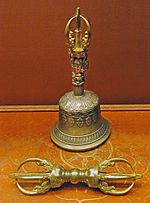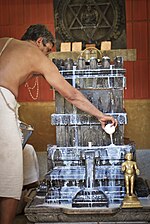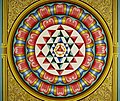Shingon (真言宗, Shingon-shū, "True Word / Mantra School") is one of the major schools of Buddhism in Japan and one of the few surviving Vajrayana lineages...
92 KB (11,496 words) - 22:23, 28 October 2024
being shingon (which is also used as the proper name for the Shingon sect). According to Alex Wayman and Ryujun Tajima, "Zhenyan" (or "Shingon") means...
94 KB (11,213 words) - 18:49, 6 November 2024
The Shingon-risshū (真言律宗, "The Shingon-Vinaya school") is a comparatively small medieval sect of Buddhism in Japan that arose in the Kamakura period as...
973 bytes (114 words) - 02:26, 28 August 2020
Vairocana (category Shingon Buddhism)
schools including the Japanese Kegon, Shingon and esoteric lineages of Tendai. In the case of Huayan and Shingon, Vairocana is the central figure. In Chinese...
29 KB (3,057 words) - 07:28, 29 October 2024
Shingon (Burmese: ရှင်ကုန်း [ʃɪ̀ɰ̃ ɡóʊɰ̃]; lit. 'Lady Humpback') is one of 37 nats in the official Burmese pantheon of nats. She was a maid of King Thihathu...
875 bytes (74 words) - 21:35, 5 November 2024
Kōyasan Shingon-shū (高野山真言宗) is a Japanese sect of Shingon Buddhism. Headquartered on Mount Kōya in Wakayama Prefecture, it is also the oldest and largest...
505 bytes (42 words) - 16:54, 17 November 2023
Vajrayana (section Shingon Buddhism)
secret teachings) or by the term Shingon (a Japanese rendering of Zhēnyán), which also refers to a specific school of Shingon-shū (真言宗). The term "Esoteric...
98 KB (11,722 words) - 16:15, 10 November 2024
Lüzong and Oxhead school) Shingon (Zhenyan) Kōyasan Shingon-shū Shingon Risshu (Syncretized with Risshū) Shingon-shu Buzan-ha Shingon-shū Chizan-ha Shinnyo-en...
42 KB (4,299 words) - 13:15, 9 November 2024
emanations of Amitābha. In Shingon Buddhism, Amitābha is seen as one of the thirteen Buddhas to whom practitioners can pay homage. Shingon, like Tibetan Buddhism...
27 KB (2,753 words) - 23:54, 4 November 2024
Kūkai (category Shingon Buddhism)
Japanese Buddhist monk, calligrapher, and poet who founded the esoteric Shingon school of Buddhism. He travelled to China, where he studied Tangmi (Chinese...
35 KB (4,483 words) - 15:37, 27 October 2024
Abhisheka (section Shingon Buddhism)
present in Tibetan Buddhism as well as in Chinese Esoteric Buddhism and in Shingon Buddhism. The abhiṣeka was originally used as a consecration rite. Water...
9 KB (875 words) - 19:16, 6 November 2024
Hawaii Shingon Mission or Shingon Shu Hawaii (Japanese: 真言宗ハワイ別院, Shingonshu Hawai Betsuin, formerly the Shingon Sect Mission of Hawaii) located at 915...
6 KB (631 words) - 06:35, 28 October 2024
Mandala (section Shingon Buddhism)
Mahayana Buddhism – Shingon Buddhism – makes frequent use of mandalas in its rituals as well, though the actual mandalas differ. When Shingon's founder, Kūkai...
41 KB (4,616 words) - 03:36, 7 November 2024
Shinshō (真紹) (797–873) was a Japanese Buddhist monk of the Shingon sect and founder of the Eikan-dō Zenrin-ji in Heian-kyō (modern Kyoto). He studied...
907 bytes (88 words) - 19:56, 15 October 2022
million believers, followed by Nichiren Buddhism with 10 million believers, Shingon Buddhism with 5.4 million, Zen Buddhism with 5.3 million, Tendai Buddhism...
99 KB (11,872 words) - 19:45, 12 October 2024
Mount Kōya (category Shingon Buddhism)
sect of Shingon Buddhism. First settled in 819 by the monk Kūkai, Mount Kōya is primarily known as the world headquarters of the Kōyasan Shingon sect of...
14 KB (1,224 words) - 01:35, 26 September 2024
Sokushinbutsu (category Shingon Buddhism)
induced their own death by starvation. There is a common suggestion that Shingon school founder Kukai brought this practice from Tang China as part of secret...
11 KB (1,212 words) - 16:17, 9 November 2024
Womb Realm (category Shingon Buddhism)
Diamond Realm, form the core of Chinese Tangmi and Japanese Tendai and Shingon Buddhist rituals, including abhisheka "initiation". In this ritual, new...
7 KB (583 words) - 10:18, 22 October 2024
example is the Mantra of Light (kōmyō shingon), which is common in Japanese Soto Zen and was derived from the Shingon sect. In Chinese Chan, the usage of...
197 KB (22,963 words) - 16:37, 3 November 2024
Visualising & Writing Buddhist Mantras Shingon Buddhist International Institute. "Jusan Butsu – The Thirteen Buddhas of the Shingon School". Archived from the original...
8 KB (437 words) - 11:16, 7 November 2024
Madhyamaka Yogachara Vajrayana Tibetan Buddhism Chinese Esoteric Buddhism Shingon Dzogchen Theravada Navayana Early Buddhist schools Pre-sectarian Buddhism...
232 KB (26,431 words) - 17:46, 10 November 2024
They include Indo-Tibetan Buddhism, Chinese Esoteric Buddhism, Japanese Shingon Buddhism and Nepalese Newar Buddhism. Although Southern Esoteric Buddhism...
119 KB (14,974 words) - 07:00, 7 November 2024
and Shingon temples. Some temples include Kimpusen-ji in Yoshino (Tendai), Ideha Shrine in the Three Mountains of Dewa and Daigo-ji in Kyoto (Shingon)....
19 KB (2,055 words) - 19:26, 30 August 2024
itself derived from Indo-Chinese tantric masters such as Amoghavajra. Shingon focuses almost exclusively on esotericism, while Tendai views exoteric...
14 KB (1,768 words) - 06:11, 2 October 2024
Vairocanābhisaṃbodhi Sūtra (section Shingon lineage)
(Daibirushana jōbutsu jinpen kajikyō), it is one of two central texts in the Shingon school, along with the Vajrasekhara Sutra. Both are also part of the Tendai...
15 KB (1,923 words) - 16:11, 6 November 2024
Shikoku Pilgrimage (category Shingon Buddhism)
Prefecture, which was settled by Kūkai and remains the headquarters of Shingon Buddhism. The 21 kilometres (13 mi) walking trail up to Kōya-san still...
37 KB (1,559 words) - 23:19, 30 August 2024
(声明) is a style of Japanese Buddhist chant, used mainly in the Tendai and Shingon sects. There are two styles: ryokyoku and rikkyoku, described as difficult...
2 KB (141 words) - 21:54, 9 September 2024
Thirteen Buddhas (category Shingon Buddhism)
particularly in the Shingon and Tendai sects of Buddhism. The deities are, in fact, not only Buddhas, but also include bodhisattvas. In Shingon services, lay...
11 KB (913 words) - 13:37, 19 August 2024
Gautama Buddha, he is able to purify transgressions. Kūkai, the founder of Shingon Buddhism, met a famous monk who is said to have repeatedly chanted a mantra...
10 KB (905 words) - 07:52, 11 September 2024
Traditions Japanese Buddhism Japanese Zen Sōtō school Dogen Rinzai school Eisai Shingon Kukai Japanese Confucianism Fujiwara Seika Hayashi Razan Nakae Tōju Itō...
42 KB (4,597 words) - 20:20, 24 October 2024
























